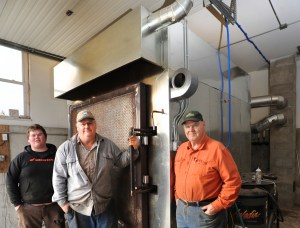For the past four years, David Barker has been tinkering with the idea of becoming more self-sufficient at his farm in Leeds. It is a traditional Maine farm where his wife takes care of the milking and he and his father and sons work the fields, barns and dozens of other chores required to sustain the working dairy farm.
Barker works from dawn to dusk — not only on his farm. He takes part-time jobs fixing other farmers’ tractors and machinery in his workshop.
Heating the barns, workshops and his house eats up a major chunk of his profits, so for the past four years he has been working on an idea that he hopes will help make him more self-sufficient and increase his bottom line.
After hearing about farmers in the South burning cornstalks to produce energy, he designed (in his head, with no help from a computer) and built his own furnace to not only heat the structures, but also the hot water needed to wash the milking equipment for the 100 cows they milk each day. At any given time, he has about 225 cows in his herd, including young stock.
Through trial and error, he has built from scratch the massive furnace. It is controlled by a computer that regulates the air flow and water pressure through 200 feet of 2-inch pipe winding through the heat exchanger, underground to the buildings and back to the 6,500-gallon tank he made using the base of an old silo. He lined it with 4-inch Styrofoam and covered it with rubber roofing.
Recent testing has been mostly successful, but more “tinkering” needs to be done before it goes online, Barker said. He recently cut a hole in the bottom of the furnace to attach a blower he is building to force more air to increase its efficiency.
“It will burn so hot that you should not see any smoke coming from the chimney,” he said.
His fuel is abundant because it is a byproduct of the feed for his cattle. After stripping the corn, the stalks are bundled in 4-foot bales that are made using a standard hay-baler. Hundreds are lined up on the edge of his cornfield nearby.
“I figure each one will burn in about three hours, and from the testing we have done so far, I am pretty confident that I will only need to burn one a day,” he said.
He has no plans to patent the furnace and is willing to share his idea with other farmers to help them reduce their dependence on foreign oil. He hopes to collect on a small grant promised by the Department of Agriculture when the project is completed.

Comments are no longer available on this story